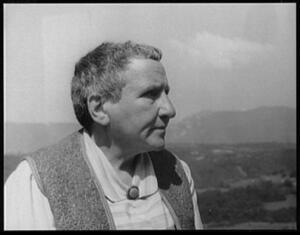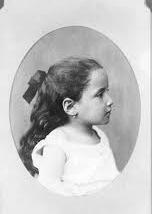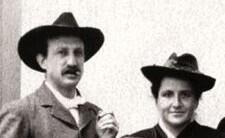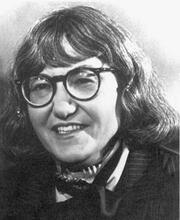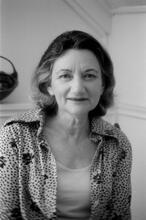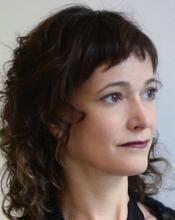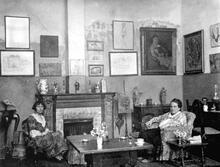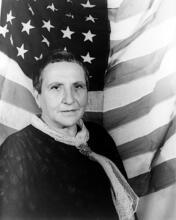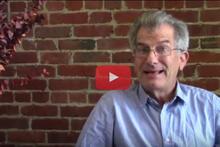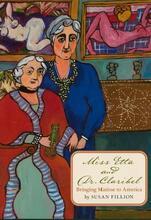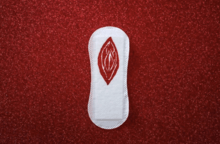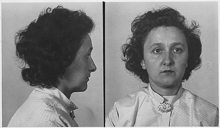Gertrude Stein
Gertrude Stein, the American modernist writer, was an international celebrity, an artistic iconoclast, and a self-proclaimed genius. Her literary experiments still puzzle structuralist, deconstructionist, and feminist critics. Her contribution to American literature, however, is not in doubt: Scholars consider Stein an important innovator whose attention to language and questioning of narrative conventions influenced such writers as Ernest Hemingway and Sherwood Anderson. A legendary personality, from the early 1900s, when she first arrived in Paris, until her death in 1946, she reigned at the center of a flourishing Parisian salon whose guests included Pablo Picasso and Henri Matisse, Edith Sitwell and Harold Acton, F. Scott Fitzgerald and Thornton Wilder, and scores of other writers, artists, and musicians.
Formative Years: Family and Education
Gertrude Stein was born on February 3, 1874, in Allegheny, Pennsylvania, the youngest of five children—three boys and two girls—of Daniel, a businessman, and Amelia (Keyser) Stein. Both parents were of German Jewish descent. Her father was born in Bavaria and immigrated to the United States in 1841. The Steins recognized their cultural roots in Judaism, but although Daniel and Amelia Stein were members of a synagogue throughout Gertrude’s childhood, the Stein children were not raised to be practicing Jews. Nevertheless, Stein grew up believing strongly that Jews shared certain personal traits, such as superior intelligence, financial acumen, and loyalty to one another.
When Gertrude was an infant, the Stein family left Pennsylvania and traveled back to Europe. Stein spent her early years in Austria and later in France. In 1879, the Steins returned to America, settling first in Baltimore, where Amelia Stein had relatives, and then, in 1880, moving to Oakland, California, where Stein spent the rest of her youth. Of Oakland she was later to utter the famous remark, “There is no there there,” claiming that she could no longer discover her youthful memories in the changed community. Growing up, she countered a lack of cultural stimulation by reading voraciously. Shakespeare, Scott, Richardson, Fielding, and Wordsworth were among her favorite authors.
After both parents died—her mother in 1888 and her father in 1891—Stein’s eldest brother, Michael, moved his four siblings to San Francisco, where he directed a street railway company. In 1892, with her brother Leo and sister Bertha, Stein moved to Baltimore to live with an aunt. Throughout Stein’s youth, Leo was her closest companion and confidante. When he decided to leave Baltimore to enroll at Harvard, Stein followed without hesitation.
Because Harvard was closed to women, in the fall of 1893 Stein enrolled at the Harvard Annex, the precursor to Radcliffe College, where she studied for four years, graduating in 1897. In a composition class in 1896, Stein wrote “The Modern Jew Who Has Given Up the Faith of her Fathers Can Reasonably and Consistently Believe in Isolation,” an essay that reflects her rejection of Jewishness as religion in favor of race, which she argues should be preserved by the prohibition of intermarriage. Stein studied with William James, George Santayana, Josiah Royce, and Hugo Munsterberg, among others, and later cited James as the most significant influence of her college years. Stein worked in James’s psychology laboratory, carrying out experiments in automatic writing that became the basis of her first publication, “Normal Motor Automatism” (coauthored with a classmate, Leon Solomons), which was published in the Psychological Review in 1896.
Although some critics later connected Stein’s experimental writings to these laboratory experiments, it is more likely that the experiments inspired Stein’s interest in subconscious layers of personality. In early notebooks and various literary portraits, one can see Stein attempting to discover the “bottom nature,” as she put it, of her friends, acquaintances, and her own personality. Because Stein expressed an interest in studying psychology, James suggested that she continue her education at the Johns Hopkins Medical School. Following his advice, she began to study at Johns Hopkins in the fall of 1897. But her enthusiasm for scientific coursework soon waned, and her grades plummeted.
Besides disappointment in her studies, Stein, not for the first time, suffered in her personal life. Her occasional writings during her undergraduate years at Radcliffe reveal a troubled and depressed young woman, unable to envision herself fitting into such prescribed roles as wife and mother. Her “red deeps,” as she termed her tumultuous feelings, became exacerbated at Johns Hopkins, where her love for another woman was not reciprocated. This emotional crisis made its way into her first extended piece of fiction, Things As They Are (1903), which was published posthumously.
Starting Over in Europe
Lonely and despondent, Stein left Johns Hopkins and followed her brother Leo to Europe, where he had recently settled. The two lived first in London in 1902 and then in Paris in 1903, where Stein joined him in his flat at 27, rue de Fleurus, in the Montparnasse district of the city. Soon their brother Michael, his wife Sarah, and their son Allan, took up residence nearby.
Although the Steins’ expatriation was not unusual at a time when many artists, writers, and intellectuals found a more hospitable environment in Europe than in the United States, Stein sought in Paris a liberation from the strictures of American society that made her feel like an outcast. In a community of artists and writers who were trying to invent a new language in painting, poetry, and prose, Stein was able to create her own identity as a literary pioneer. In a community that accepted and even affirmed a wide range of sexual identities, Stein did not need to fear censure.
Stein began writing earnestly in Europe. Her two early works, Three Lives, a collection of stories loosely modeled on Flaubert’s Trois Contes, and The Making of Americans, a novel, are based largely on her own life, concerns, and struggles. The protagonist of each story in Three Lives is a woman who does not conform to mainstream society because of ethnic or racial difference. The setting of Baltimore serves to represent America at large. Of the three stories, “Melanctha” has received most attention, partly because it is the longest story, and partly because Melanctha, the central character, and her lover, a physician, are African American. In depicting their troubled love affair, Stein pits the sexually impulsive Melanctha against the more cerebral Jeff Campbell to portray the pain and frustration both feel as they try, but fail, to understand each other. Alienated from white society because of their color, they cannot find a sense of community with each other. Written with the pain of her own thwarted affair still afflicting her, Stein was concerned less with exploring racial issues than with reconsidering her own feelings of loneliness.
The Making of Americans, written from 1906 to 1911, was not published in its entirety until 1966. More than Three Lives, this book is stylistically unconventional, reflecting Stein’s interest in creating a sense of “continuous present” that represents our experience of time. Even an abridged version that appeared in 1934 seemed to most readers bloated and inaccessible because of its long, rambling, repetitious sentences and paragraphs. In her effort to explore the shaping of American identity, she used herself and her family as representative Americans. The main characters, the Herslands, are barely fictionalized versions of the Steins, with Gertrude Stein appearing as the depressed and unhappy Martha. Much of the book describes and reiterates autobiographical episodes. While it has served some of Stein’s biographers as a source for documenting her life, it has not won Stein many admirers.
Nevertheless, writing these two works persuaded Stein that she had found her vocation. Her growing confidence, however, was not evident to visitors at the rue de Fleurus. Friends who remember Stein in the first years after her arrival in Paris describe a quiet, reticent woman who sat in the shadow of her loquacious brother. Leo, eagerly engaged in art collecting and formulating his own aesthetic theories, claimed the role of family intellectual. Unfortunately, he had no admiration for his sister’s writing.
A Treasured Companion
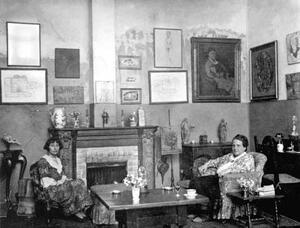
Institution: Yale Collection of American Literature, Beinecke Rare Book and Manuscript Library
But Stein soon found ample encouragement from Alice B. Toklas, who arrived in Paris in 1907 and soon replaced Leo in Stein’s affections and in her life. When Leo moved out of the rue de Fleurus apartment, Toklas moved in, becoming Stein’s lifelong companion. They continued to make their home in Paris and later spent part of the year at Bilignin in the south of France, where they rented a house.
With Toklas as appreciative reader, Stein felt free to experiment more boldly than she had before. In Tender Buttons (1912), she created verbal collages that have been compared, in effect, to the cubist paintings of her friends Picasso, Georges Braque, and Juan Gris. Stein aimed in these pieces, and also in many later works, to revitalize language by stripping words of their historical and cultural connotations. Sometimes she believed that merely by repeating a word, she could divest it of its contextual barnacles. The most familiar line that demonstrates this technique comes from the poem “Sacred Emily”: “Rose is a rose is a rose is a rose.” In her attempt to achieve an accurate representation of her own experienced reality, she juxtaposed words and phrases in an order that defied conventional logic and readers’ expectations. Most of Stein’s experimental works were published in small literary magazines or by vanity presses.
During World War I, Stein and Toklas left Paris for Mallorca. During this period of isolation, Stein wrote short pieces in which she developed further the technique she had used in Tender Buttons, juxtaposing mundane descriptions (of weather conditions and food, for example), bits of conversation, and random reflections. Allusions to Jewish identity show Stein grappling with stereotypes of Jews as geniuses or degenerates. The Mallorcan pieces reflect Stein’s interest not only with artistic experimentation, but with exploring her feelings about Alice Toklas, their relationship, and their future together. These feelings emerge in exclamations of exuberant love, sometimes expressed in private code, as well as revelations of jealousy and insecurity. Although some biographers portray the Mallorcan period as an idyllic honeymoon, a careful reading of Stein’s works suggests that the atmosphere often was tense and even volatile.
When Stein and Toklas returned to France in 1916, the two women volunteered their services for the American Fund for French Wounded. Stein learned to drive, and she and Toklas delivered hospital supplies throughout the south of France. The sight of the two atop their Ford truck has been recalled vividly in the memoirs of many of their contemporaries.
In the 1920s, Stein’s lively literary and artistic salon attracted a growing population of young American expatriates whom Stein called the Lost Generation—lost, she said, because they had been too young to fight in World War I and therefore had found no political or social cause to inspire them. Among these lost young men, the most notable was Ernest Hemingway, whose attentions to Stein inspired Toklas’s jealousy. Toklas eventually succeeded in banning Hemingway from the rue de Fleurus, but not before Hemingway took Stein’s words for the epigraph of his first novel, The Sun Also Rises.
In 1926, when Stein was invited to lecture at Oxford and Cambridge, she offered her first sustained discussion of the theoretical basis for her experimental prose. In “Composition As Explanation,” she argues that cultural and artistic contexts affect the way a literary work is both written and read. But writer and reader sometimes do not share the same context at the same time. When writers bring to their works new patterns of thinking and perceiving, readers may deem their creations avant-garde and, sometimes, impenetrable. Stein cited her own invention of the “continuous present” as a technique that was “natural” to her, but difficult for some of her readers. “Composition As Explanation” was followed by such pieces as “Sentences and Paragraphs” (1930) and What Are Masterpieces and Why Are There So Few of Them (1935), both of which served as guides for understanding modernist literary experiments. These cogent, thoughtful works testify to the deep and complex intellectual basis of Stein’s literary productions.
Popularity
By the 1930s, Stein had gained a reputation as a literary innovator, but her works had only a small readership: the writers who frequented her salon, the readers of the “little magazines” in which she was published, and her circle of Parisian friends. She longed for wider recognition, however, and decided to take the advice of some American friends—the music critic Carl Van Vechten and the publisher Bennett Cerf, among them—and write her memoirs. Although the book was unlike her literary experiments, Stein chose an innovative literary device: creating a narrative from Toklas’s often acerbic point of view. According to Stein, Toklas’s version of events was always definitive. When The Autobiography of Alice B. Toklas was published in 1933, Gertrude Stein at last found the fame that she had sought for so long. This witty, gossipy, and irreverent memoir created the public legend of Gertrude Stein.
Suddenly, Stein became a sought-after personality on both sides of the Atlantic. The literary lion who landed in New York in October 1934 for a much-publicized lecture tour bore no resemblance to the vulnerable young woman who had left three decades before. Reporters thronged the ship, interviewers and photographers followed her everywhere, and her fans packed auditoriums to hear her talk.
Yet as delighted as she was with recognition and accolades, privately Stein wondered if her identity as a writer had been compromised. In experimental pieces written in the 1930s, she questioned the effect of publicity and readers’ expectations on her ability to be true to her own aims as a writer. Although she continued to produce popular books, including Everybody’s Autobiography (1937) (a sequel to The Autobiography of Alice B. Toklas); Paris, France (1940), an homage to her adopted city; and Brewsie and Willie (1945), an affectionate tribute to the American soldiers who fought in World War II, she never stopped writing experimental prose.
Because Stein never confined herself to any genre, some readers may know her through her plays, which sometimes find their way into the repertory of experimental or college theatre groups. Although many of her plays were not written to be staged, two were set to music by Stein’s friend Virgil Thomson: Four Saints in Three Acts, an opera featuring Saint Theresa of Avila, and The Mother of Us All, which celebrates the life and work of Susan B. Anthony. Their repetitious lyrics, lack of character development or plot, and unremarkable score have not earned them wide acclaim.
Stein’s reputation as an avant-garde writer is based largely on her experimental, hermetic works: pieces that have been collected in eight volumes published by Yale University Press and in several other collections. In evaluating criticism of these works, it is important to remember that Stein often wrote hermetic pieces in order to veil her lesbian relationship with Toklas and to explore personal issues that she did not want outsiders to understand. Although Stein defended her work by asserting that she wanted to challenge her readers’ preconceptions about language and narrative, she also used her writing to dissect and probe her own “bottom nature.” While it is tempting to explain Stein’s experimental writing as her rebellion against a literary patriarchy, or her creation of a literary cubism, no single explanation is viable for all of her works.
Stein and Toklas remained in France during World War II, during which Stein wrote a controversial essay praising Maréchal Petain, which has been the subject of much scholarship. Their American friends feared for the safety of the two Jewish women and encouraged them to flee. But they fled only as far south as Bilignin, where they waited out the war and scrounged for food and necessities. It is likely that they were protected by French friends, notably Bernard Fay, who had ties to the Vichy government. Stein herself never spoke out on behalf of the persecuted Jews.
After the war, Stein, who had suffered from stomach problems throughout her life, was diagnosed with stomach cancer. She died on July 27, 1946, at the American Hospital at Neuilly-sur-Seine. Gertrude Stein is buried at the Père-Lachaise Cemetery in Paris.
Selected Works by Gertrude Stein
The Autobiography of Alice B. Toklas (1933).
Everybody’s Autobiography (1937).
The Making of Americans (1966).
Paris, France (1940).
Three Lives (1909).
Wars I Have Seen (1945).
The Writings of Gertrude Stein, Yale edition. 8 vols. (1951–1958).
Meyerowitz, Patricia, ed. Gertrude Stein: Writings and Lectures 1911–1945 (1967).
Vechten, Carl Van, ed. Selected Writings of Gertrude Stein (1962).
Dydo, Ulla E., ed. A Stein Reader (1993).
Stein, Writings 1903-1932 and Stein, Writings 1933-46 (1998).
Burns, Edward, ed. The Letters of Gertrude Stein and Thornton Wilder (1996).
Burns, Edward, ed. The Letters of Gertrude Stein and Carl Van Vechten.(1986).
Turner, Kay, ed. Baby Precious Always Shines: Selected Love Notes Between Gertrude Stein and Alice B. Toklas (1996).
AJYB 49:618.
BEOAJ.
Bridgman, Richard. Gertrude Stein in Pieces (1970).
Brinnin, John Malcolm. The Third Rose: Gertrude Stein and Her World (1959), and Selected Operas and Plays, editor (1970).
Damon, Maria. “Gertrude Stein’s Jewishness, Jewish Social Science, and the ‘Jewish Question,’” Modern Fiction Studies, Fall 1996, 42.3: 489-506.
DeKoven, Marianne. A Different Language: Gertrude Stein’s Experimental Writing (1983).
DAB 4.
EJ.
Haas, Robert Bartlett, ed. How Writing is Written (1974), A Primer for the Gradual Understanding of Gertrude Stein (1971), and Reflections on the Atom Bomb (1973).
Malcolm, Janet. Two Lives: Gertrude and Alice (2007).
Mellow, James. Charmed Circle: Gertrude Stein and Company (1974).
Morris, Roy. Gertrude Stein Has Arrived (2019).
NAW.
Obituary. NYTimes, July 28, 1946, 40:6.
Simon, Linda. The Biography of Alice B. Toklas (1977, reprint 1991).
Simon, Linda, ed. Gertrude Stein Remembered (1994).
Stein, Gertrude. The Autobiography of Alice B. Toklas. Illustrated by Maira Kalman. New York: Penguin Press, 2020.
Stein, Gertrude. Papers. American Literature Collection. Beinecke Library, Yale University, New Haven, Conn.
UJE.
Wagner-Martin, Linda, “Favored Strangers”: Gertrude Stein and her Family (1995).
Walker, Jayne. “Gertrude Stein.” In American Women Writers (1983), and The Making of a Modernist: Gertrude Stein from Three Lives to Tender Buttons (1984).;
White, Ray Lewis. Gertrude Stein and Alice B. Toklas: A Reference Guide (1984).
Will, Barbara. Gertrude Stein: Modernism and the Problem of ‘Genius’ (2000) and Unlikely Collaboration: Bernard Fay and the Vichy Dilemma (2011).
WWIAJ (1938).
WWWIA 2.
Wineapple, Brenda. Sister Brother: Gertrude and Leo Stein (1996).

